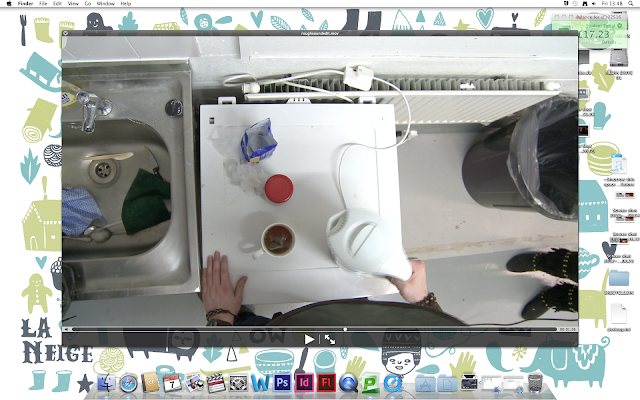From the rough cut, we could all see that a lot more work would be needed to get it up to scratch. Here are all the major problems we had to contend with.
People in shot. Booms in shot. Weird shadows in shot. Random items in shot which shouldn't really be there. The normal really for an amateur film, but at the end of the day we are only first years, and this film definitely was a learning curve for us all. This shot (underneath) in particular was bad, as we all really liked the footage for this section, but it was too hard to cut Sara's shoes out of this shot without loosing quality, so the whole shot had to be scrapped. In some of the sections we were able to crop the footage by using the widescreen video filter, which allowed us to move the footage up and down to hide various things, as well as giving the over-the-top (mocking of a) blockbuster feel. By using this effect I could also rearrange the footage to work with the rule of thirds, making this even more cinematic, and more pleasant to view.

Mine and James' main concern was how bad the sound quality was, as there was far too much ambient sound, and the main sound effects or voices sound muffled in half the shots, as well as the levels needing changing which wasn't helped by the inconsistent use of the boom mic. After trying to edit the existing sound, and failing, James suggested that we used sound effects and repeated ambient sound that we had recorded (with the levels lowered) instead, other than the first opening scene where the speech is still needed. I was really impressed with James' work on the sound editing, even though I was only the assistant editor for the sound section, I am still proud of certain sound effects used and how well James managed to match them with the footage. Some audio is obvious that it has been added, but a lot of the subtle quiet noises fit with the video really well. One thing that was mentioned in the Critique was that the levels of sound for the whole video was far too low and to raise them all. So James selected all of the audio footage and placed it into a new sequence, which makes the audio all one strip, allowing you to change the level of everything all in one go (and potentially sound edit using the key framing tool, but we didn't need to do that).
As mentioned in the 'filming' post, the shot types were difficult to work with, such as jaunting camera moves because of not using a tripod, zooms, pans and bad tracking. However James and I managed to cut most of this awkward footage out, and make the shots flow as well as possible together. Other things I mentioned in the 'filming' post was the trouble we had with the footage of the computer screen wavering, so we cut the footage down to the section where it is least noticeable (due to a random change in natural light). We also had the task of de-interlacing the footage, which was surprisingly easy to do (it is literally the flick of a button).
One of our other major problems throughout the film was lighting, as in some shots we were able to use the artificial lights, but in most we had to make to with whatever natural light was coming through. This made the colour tones and look of each shot completely different. When talking to Matt Burton about colour correction he said to only ever change the highlight and mid tones, and avoid touching the blacks (as it darkens the footage too much), and to use a mixture of yellow and blue tones which will balance out.
In the end critique where we showed our video's, nobody mentioned the colour, or any issues with the film regarding it being over exposed, which is great as before it was colour corrected it was one of the first things people picked up on in the film as bad. This goes to show that even unnoticeable changes to the eye when watching a piece of footage, could have made such a dramatic difference to your viewing experience.
Overall, even though I am unhappy with the finished film, I am really proud of how different the finished video is compared to the rough cut, and how many subtle changes we were able to make along with more obvious changes. Although it was personally frustrating for me to be involved in the post production work, and the very last stages were left down to solely me to do alone, as I wasn't initially down to be doing any of the editing, I did find it interesting to do, and I felt it did push me to learn skills I have previously avoided such as colour correction.





No comments:
Post a Comment